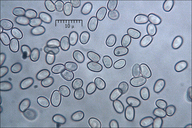date of photo Sep 17, 2016
latitude 46.36008 longitude 13.70278
View on Google Maps.
location
Lower Trenta valley, between villages Soča and Trenta, right bank of river Soča, below Na Melu place, next to the trail from Trenta 2b cottage and Trenta 2a cottage, East Julian Alps (Posočje, Slovenia)notes Slo.: žametna podvihanka - syn.: Paxillus atrotomentosus (Batsch.) Fries - Habitat: edge of mixed wood, Fagus sylvatica, Picea abies, Ostrya carpinifolia and Fraxinus ornus dominant trees; almost flat terrain; near small, dead, still standing Picea abies; calcareous, skeletal ground with many rocks; in shade, relatively warm place; partly protected from direct rain by tree canopies; average precipitations ~ 3.000 mm/year, average temperature 7-9 deg C, elevation 595 m (1.950 feet), alpine phytogeographical region. Substratum: soil/humus and rootlets in a rock crevice. Comments: Misled by an unusual color of the pilei I thought at the beginning I found Panus conchatus. However, some properties were very unusual for such determination: the mushroom's substratum doesn't seem to be wood, color of the pilei showed no violet tint, spore print was not white (or pale crème) as according to literature, and spores seemed a bit too wide. Thanks to Danny Newman at Mushroom Observer the determination was corrected to Tapinella atrotomentosa. The fit is now much better in all respects. What still surprises me is the color of the pilei. Most pictures in the literature and on net and also the appearance of Tapinella atrotomentosa, which I found two years ago not far from this place (MO observation 175366) was much darker and more gray-brown. Also substratum remains unusual. Krieglsteiner (2000) states that all finds (totally 234) in Baden-Württemberg have been found on stumps of conifers. None of them was on trunks or branches lying on ground or even buried in ground. The mushroom(s) grew from a crack of a larger, mostly buried calcareous rock. The crack was 1-1.5 cm wide and filled with humus and some small (max 4 mm in diameter) rootlets probably of neighboring dead Picea abies. I dug about 30 cm in the crack and surrounding soil and found no buried massive dead wood present. Three fuzzed 'stalks' with partly confluent pilei found; their (across all of them) dimensions 13 x 10.5 cm; the stalks' length 3-4.5 cm, the largest 'diameter' 3.2 cm; smell mild, mushroomy; taste not strong but distinctive, a kind of mushroomy, lightly bitter, after some time lightly unpleasant; SP abundant, ocher - hazel-nut color, oac757, essentially the same color as of gills. Spores smooth. Dimensions: 4,9 [5,5 ; 5,7] 6,2 x 3,2 [3,6 ; 3,8] 4,2 microns; Q = 1,3 [1,5] 1,7; N = 40; C = 95%; Me = 5,6 x 3,7 microns; Qe = 1,5. Olympus CH20, NEA 100x/1.25, magnification 1.000 x, oil, fresh material, in water. AmScope MA500 digital camera. Herbarium: Mycotheca and lichen herbarium (LJU-Li) of Slovenian Forestry Institute, Večna pot 2, Ljubljana, Index Herbariorum LJF Ref.: (1) Id'ed by Danny Newman, MO. (2) J. Breitenbach, F. Kraenzlin, Eds., Fungi of Switzerland, Vol.3. Verlag Mykologia (1991), p 90. (3) R.M. Daehncke, 1200 Pilze in Farbfotos, AT Verlag (2009), p 104. (4) M. Bon, Parey's Buch der Pilze, Kosmos (2005), p 50. (5) S. Buczacki, Collins Fungi Guide, Collins (2012), p 420. (6) R. Phillips, Mushrooms, Macmillan (2006), p 208. (7) D. Arora, Mushrooms Demystified, Ten Speed Press, Berkeley (1986), p 478. (8) G.J. Krieglsteiner (Hrsg.), Die Grosspilze Baden-Württembergs, Band 2., Ulmer (2000), p 346.camera AmScope MA500 digital
contributor's ID # Bot_1005/2016_DSC4931 photo category: Fungi - fungi
|
